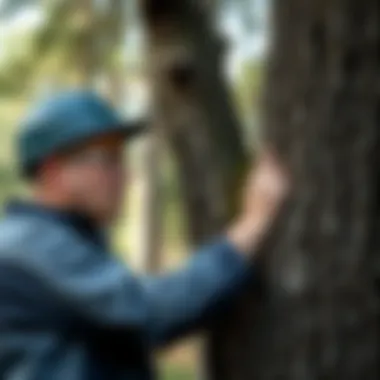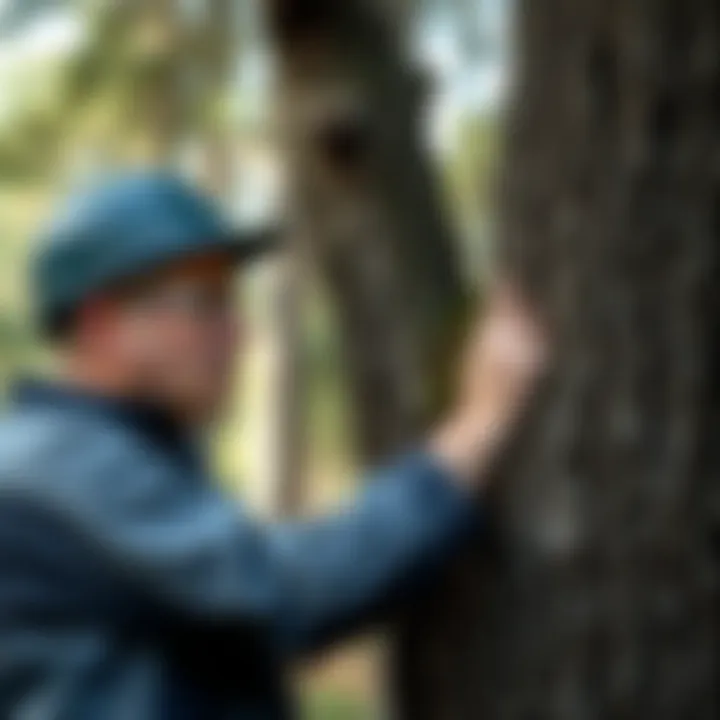Choosing the Right Tree Cutting Service for You


Intro
Navigating the realm of tree cutting services goes beyond just wielding a chainsaw. It's an intricate dance between the knowledge of different tree species, the surrounding environment, and sustainable practices that ensure the health of our woodlands. As more people recognize the importance of forests, understanding the right practices in tree management has become paramount. This article aims to guide forestry professionals, landowners, and environmental advocates through the complexities of tree services, teaching them not just to manage trees, but to foster thriving ecosystems.
Overview of Forestry Practices
Importance of Foresting
Forests are vital for our planet, serving as lungs for the Earth, filtering carbon dioxide and releasing oxygen. They provide habitat for countless species, regulate water cycles, and stabilize soils. The significance of maintaining healthy forests cannot be overstated. Yet, urbanization and land clearing pose threats, increasing the necessity for effective forestry practices.
Types of Forestry Practices
Understanding the diverse types of forestry practices is essential for making informed cutting decisions. Here are a few prominent methods:
- Selective Cutting: This practice involves removing specific trees while leaving the overstory intact, promoting a diverse ecosystem.
- Clear-Cutting: A controversial method where all trees in an area are cut down, often replaced by single-species plantations; it can have profound ecological impacts if not managed properly.
- Shelterwood Cutting: This method gradually removes trees in stages, allowing younger trees to thrive under the protection of mature ones.
These methods come with their own set of advantages and disadvantages, deeply influencing the overall ecological balance.
Best Practices for Sustainable Woodland Stewardship
Principles of Sustainable Forestry
Sustainable forestry is underpinned by principles that emphasize ethical management of forests. This can include, but is not limited to:
- Maintaining biodiversity by protecting various species of flora and fauna.
- Ensuring that forestry practices allow for the regeneration of trees and other plant life.
- Minimizing environmental impact during operations, which helps preserve soil integrity and water quality.
Techniques for Land Management
Efficient land management calls for a blend of innovative and traditional methodologies. Here are some effective techniques:
- Thinning: Reducing the density of trees allows remaining ones to grow stronger and healthier.
- Cover Cropping: Planting other crops or vegetation can help prevent soil erosion and provide additional habitat.
- Controlled Burns: Used to manage undergrowth and prevent larger forest fires, this method requires careful planning and expertise.
Innovative Techniques in Forestry
Latest Technological Advancements
Technology plays a critical role in modern forestry. Innovations such as drone surveys, remote sensors, and data analytics are revolutionizing tree management. For example, drones can efficiently map vast forest lands, identifying areas needing attention while providing real-time data on forest health.
Integrating Traditional Knowledge with Modern Science
While technology is advancing rapidly, the wisdom passed down through generations of forestry leaders remains invaluable. Combining age-old techniques—like selective harvesting strategies with contemporary scientific approaches can yield significant benefits. This fusion presents a holistic approach to forest stewardship, balancing productivity with conservation.
"Sustainable forestry strikes the delicate balance between human needs and ecological integrity. We cannot afford to disregard either." – Environmental Advocate
By carefully navigating the various methods and practices surrounding tree management, one can pave a path to better forest stewardship.
For more insights on forestry practices, check out forestryweb.com, and for recent scientific advancements, visit sciencedirect.com.
Culmination
The journey through tree cutting services demands thoughtful navigation. By grounding decisions in robust forestry practices, we can achieve not only the goals of land management but also ensure the well-being of the ecosystems we cherish.
Understanding Tree Services
In any realm concerned with environmental care and management, understanding tree services is essential. It serves as the backbone of not only maintaining the aesthetics of our landscapes but also of ensuring ecological balance. By comprehending various aspects of tree services, landowners, forestry professionals, and enthusiasts alike can make informed decisions that resonate through the ecosystems they manage.
Defining Tree Services
Tree services encompass a broad spectrum of activities focused on maintaining trees, from basic care to specialized management practices. These services typically include:
- Tree Removal: This is where an unhealthy or problematic tree is safely and effectively taken down. It's crucial in preventing potential hazards, such as falling branches.
- Tree Pruning: Here, parts of the tree are cut away to improve health, structure, or aesthetic appeal. Pruning can invigorate leaf growth and fruit production, leading to healthier trees.
- Stump Grinding: After a tree is felled, its stump may remain. This service grinds it down to level the ground and eliminate potential tripping hazards.
Understanding these definitions is not merely academic; it helps in recognizing when and why a service is necessary.
Importance of Proper Tree Care
Proper tree care isn't just about cutting branches or removing stumps; it's about nurturing the ecological community that thrives in our backyards and parks. Well-maintained trees provide numerous benefits, including:
- Air Quality Improvement: Trees act as natural air filters. Through photosynthesis, they consume carbon dioxide and release oxygen, cleaning our atmosphere.
- Biodiversity Support: Healthy trees are home to countless species, from birds to insects. By maintaining trees, we support these populations and promote biodiversity in our environments.
- Stormwater Management: Trees play a significant role in managing rainfall. Their roots absorb water, reducing runoff and alleviating flooding in urban areas.
- Aesthetic Value: Beyond their functional benefits, trees elevate the beauty of a landscape, adding character and charm to neighborhoods and parks.


"Healthy trees are not just a sight to behold; they are the lungs of our environments."
Investing time and effort into understanding how to care for trees leads to resilient, thriving landscapes, making proper tree care indispensable for sustainability.
When we talk about navigating tree services, we're really engaging in a dialogue on stewardship. It is about developing a mindset where management decisions reflect an appreciation for the interplay between human needs and nature’s intrinsic balance.
Categories of Tree Services
Tree services encompass various practices aimed at maintaining and enhancing tree health, safety, and beauty. Understanding these categories is essential for any landowner or professional looking to manage their trees effectively. The three primary categories of tree services include tree removal, tree pruning, and stump grinding. Each serves a unique purpose and offers distinct benefits, all contributing to the overall health of the ecosystem.
Tree Removal
Tree removal is often the most straightforward yet emotionally charged of the tree services. Sometimes a tree simply outgrows its place in the landscape, or perhaps it has fallen victim to disease or damage. In these situations, removing the tree becomes a matter of safety and practicality. For instance, in urban areas, a decaying tree can pose risks to power lines and buildings. The importance of proper tree removal cannot be overstated; it conserves resources and protects other flora nearby.
When considering tree removal, there are a few key factors to keep in mind:
- Permitting: Many regions require permits for tree removal, especially in urban settings or protected areas.
- Timing: Choosing the right season can influence tree removal effectiveness. Late winter or early spring might be ideal as the tree is still dormant.
- Safety Measures: Always employ professionals with the right equipment and experience; trying to do it oneself can lead to dangerous mishaps.
Tree Pruning
Pruning is an essential service that helps trees flourish by removing dead or overgrown branches. This not only improves the tree's aesthetic appeal but also promotes healthier growth and can prevent potential hazards. A well-pruned tree provides better air circulation and sunlight penetration, which is crucial for its development.
Different types of pruning include:
- Crown Thinning: This is for removing select branches to enhance light exposure.
- Crown Raising: Focuses on removing lower branches to allow clearance for walkways or vehicles.
- Crown Reduction: Involves reducing a tree's height, particularly when it poses dangers to structures or power lines.
In essence, pruning requires skill and experience. It is advisable to consult professionals who can optimize the health of the tree while ensuring safety in the process.
Stump Grinding
After a tree is removed, a stump often remains, creating an unsightly and potentially hazardous feature. Stump grinding is the process of reducing these stumps to below ground level. This not only improves the aesthetic value of the landscape but also allows for new planting opportunities in the future.
The advantages of stump grinding are manifold:
- Prevention of Pests: Left unchecked, stumps can attract insects like termites and carpenter ants.
- Frees Up Space: Once removed, the area can be repurposed for gardens, lawns, or even new trees.
- Minimal Disruption: This process is less invasive than complete excavation, causing less disturbance to the surrounding soil and ecosystem.
Choosing the Right Cut
Selecting the right cut for trees isn’t just a matter of preference; it’s a fundamentals of forestry and land maintenance. The choice of cutting technique significantly impacts not only the health of the tree in question but also the surrounding ecosystem. Understanding the nuances of tree management can lead to more sustainable practices that benefit not only the landowner but also the environment as a whole. It’s about striking that delicate balance between necessary intervention and preservation.
Assessing Tree Health
When contemplating the right cut, the first step is assessing the tree's health. This involves looking at several key aspects:
- Visual Inspection: Look for signs of disease, pests, or physical damage. The bark’s texture, leaf color, and branch structure often tell a story.
- Growth Rate: A healthy tree typically shows signs of vigorous growth. Measuring recent growth rings can provide valuable insight into the overall vitality of the tree.
- Root System Assessment: The roots are the lifeblood of any tree. Poor root health can compromise stability and nutrient uptake.
Taking stock of these elements helps in making an informed decision about what cutting approach to use. For instance, a tree in decline may require more invasive cuts, aimed at promoting healthy regrowth, whereas a robust specimen may simply need pruning to maintain its aesthetic appeal.
Factors Influencing Cutting Techniques
Several factors come into play when deciding on cutting techniques:
- Tree Species: Different species respond uniquely to cutting methods. For example, oak trees might best be managed with selective cutting, while certain pines might benefit from trimming practices that promote thicker growth.
- Seasonal Timing: The time of year you choose to cut plays a critical role. Late winter or early spring may be ideal for certain species because it minimizes stress on the plant.
- Environment and Location: Urban settings can pose unique challenges, such as proximity to power lines or buildings. In rural areas, the impact on surrounding wildlife and flora must always be considered.
“The right cut at the right time can not only boost tree health but also enhance the surrounding landscape.”
Paying attention to these factors will yield greater success in tree management. It enables professionals to align technique with ecological balance, ensuring the trees thrive long after the cutting has been completed.
By understanding how to assess tree health and the factors that influence cutting techniques, landowners can make knowledgeable choices that foster both the immediate landscape and the broader ecosystem.
Techniques in Tree Cutting
When it comes to tree cutting, the methodology employed can vastly influence not just the immediate outcome but also the long-term health of the ecosystem. Understanding the nuanced techniques in tree cutting is vital for effectively managing forests and landscapes while ensuring safety and minimizing environmental impacts. In this section, we’ll delve into three primary approaches: sectional felling, directional felling, and cutting for regrowth. Each of these techniques has its own set of benefits and considerations, which can aid forestry professionals in making more informed decisions.
Sectional Felling
Sectional felling is a method where the tree is cut down in sections or portions rather than being felled in one go. This technique is particularly useful for large or dangerous trees, where a miscalculation could result in damage to surrounding properties or risk to the crew involved. By first delimiting the tree into segments, each part can be safely lowered using ropes and rigging systems.
- Benefits of Sectional Felling:


- Safety: Reduces risk in complicated environments.
- Control: Provides greater control over where each section lands.
- Preservation: Minimizes damage to the surrounding vegetation, preserving the growth of neighboring trees.
"In urban settings, sectional felling becomes essential where trees are intertwined with buildings and power lines, blending safety with efficiency."
While this method can be labor-intensive and may require a higher level of expertise, the safety and environmental benefits it provides often outweigh these challenges. Its role in preserving ecosystem integrity cannot be overstated.
Directional Felling
Directional felling, on the other hand, involves cutting the tree in a way that directs its fall to a specific area. This technique is intuitive and often taught as part of foundational forestry training due to its effectiveness and practicality. With a proper understanding of tree anatomy and wind direction, a skilled cutter can influence where the tree lands, which is indispensable in forestry operations.
- Advantages of Directional Felling:
- Efficiency: Faster than sectional methods, helping to reduce overall labor time.
- Predictability: Experienced providers can reduce uncertainties during the cutting process.
- Environmental Protection: Aimed cuts can protect vital resources such as stream banks and mature trees.
Mastering this technique, however, does necessitate a deep understanding of the tree’s natural lean and environmental conditions. Creating a plan before commencing work is integral to achieving successful outcomes.
Cutting for Regrowth
Cutting for regrowth, or selective cutting, entails removing certain trees to promote the growth of others. This technique is becoming more popular among sustainable forestry advocates due to its ecological benefits.
- Key Considerations of Cutting for Regrowth:
- Biodiversity: Encourages a mixed-age forest that supports various species.
- Healthier Ecosystems: Reduces competition for light and nutrients among remaining trees.
- Long-term Yield: Leads to more productive future harvests and stronger tree population resilience.
Selective cutting requires careful planning and an understanding of ecological dynamics to ensure that the health of the forest remains unharmed. Well-executed cutting for regrowth can result in a thriving ecosystem that benefits both wildlife and human interests alike.
In summary, techniques in tree cutting are not just about removing trees; they encompass a broader strategy that reflects our relationship with nature. Being informed about sectional felling, directional felling, and cutting for regrowth allows professionals to make choices that align with both immediate needs and long-term sustainability goals.
Environmental Impacts
Understanding the environmental impacts of tree cutting services is crucial for making informed decisions that balance human needs with ecological health. Tree services do not just affect the trees themselves but resonate through the entire ecosystem. By ensuring that we consider the broader implications of our actions, we complement sustainable practices with effective land management. This section delves into two major aspects: ecosystem balance and soil health considerations.
Ecosystem Balance
The delicate interplay of species within an ecosystem makes it vital to approach tree cutting with care. When a tree is removed, the effects can ripple through the surrounding habitat, impacting everything from soil microorganisms to larger wildlife.
- Habitat Disruption: Each tree provides shelter and food for various species. The removal of a single tree can alter the habitat available to birds, insects, and mammals. With careful planning, tree services can mitigate these disruptions by selecting which trees to cut based on ecological assessments.
- Biodiversity Considerations: Diverse ecosystems are typically healthier. Cutting services that focus on preserving a variety of species promote resilience against pests and diseases. Proper assessments help identify trees that might pose hazards without diminishing the variety that defines the ecosystem.
“A thriving ecosystem often thrives on variety. Cutting the wrong tree can mean losing an irreplaceable connection in nature’s web.”
- Microclimate Effects: Trees contribute to microclimates, affecting humidity and temperature. Removing too many trees in a given area can lead to climate imbalances, which impact plant growth and wildlife habitats. Tree cutting services should consider the potential shifts in microclimates when planning their actions.
In summation, maintaining ecosystem balance is key. Each tree or group of trees should be carefully evaluated for the role they play in their community before deciding on their removal.
Soil Health Considerations
Soil is often an overlooked element in discussions about tree services. However, it plays a pivotal role in the growth and health of trees. Healthy soil supports rich microbial life and ensures proper nutrient cycling. The process of tree cutting, if not carried out responsibly, can lead to significant soil degradation.
- Soil Erosion: The removal of trees can expose soil to the elements, increasing erosion rates. This leads to loss of topsoil, which is essential for vegetation. Tree cutting should ideally be accompanied by measures such as planting cover crops or using erosion control blankets.
- Nutrient Depletion: Trees are integral in maintaining soil nutrient levels. They contribute organic matter through leaf litter and root systems. Removing them disrupts this cycle, leading to nutrient-deficient soil, which could hinder future plant growth. Using methods like selective cutting, rather than clear-cutting, preserves soil quality.
- Compaction Issues: Heavy machinery can compact soil during tree cutting operations, damaging its structure. Compacted soil leads to reduced aeration and impaired water infiltration. For this reason, specialized equipment and techniques should be employed to minimize soil disturbance during cutting activities.
Ethical Considerations in Tree Services
The realm of tree services does not merely revolve around cutting and removing vegetation; it thrusts into the core of responsible land stewardship. Ethical considerations in tree services are fundamental to ensuring that both immediate and long-term consequences of tree management are addressed. To navigate this multifaceted landscape effectively, one must recognize the interconnectedness of ecological well-being, community values, and sustainable practices.
Sustainable Practices
Sustainable practices in tree services encapsulate strategies that promote ecological health while fulfilling human needs. The cornerstone of these practices lies in understanding the impact of each action taken concerning tree cutting. Here are some key aspects that illustrate the significance of sustainability in tree management:
- Selective cutting: Rather than clear-cutting, wherein vast areas are stripped of trees, selective cutting allows for preserving the health of the surrounding ecosystem. This method not only maintains biodiversity but also supports habitats for wildlife.
- Reforestation Initiatives: After tree removal, planting native species is vital. This approach fosters a diverse ecosystem and helps restore any disrupted soil or water systems.
- Resource Efficiency: Utilizing modern machinery is essential but must be done responsibly. Adopting tools and methods that minimize waste and maintain soil integrity can lead to long-lasting positive outcomes.
Moreover, promoting practices that align with sustainable development allows communities and landowners to enjoy the aesthetic and economic benefits that trees provide without adversely impacting the environment.
Community Engagement
Community engagement is another critical ethical consideration in tree services. Trees are often a significant part of local cultures and landscapes. Engaging the community in decisions around tree management can lead to several key benefits:
- Local Knowledge: Residents might have insights based on years of observing the local environment that can guide better tree management practices.
- Awareness and Education: By including community voices, tree service providers can foster educational programs that promote awareness about the importance of trees and sustainable practices.
- Shared Responsibility: Involving the community ensures that trees are not just a service to be managed but valued as a collective responsibility. This collaborative spirit fosters a deeper understanding of ecological systems, leading to enhanced stewardship.
"The mark of a civilization is not how well it treats the rich and powerful, but how it treats the most vulnerable – the land and the trees included."


Engaging the community transforms tree services from a transactional operation into a collective endeavor that emphasizes responsibility and respect for the environment. Through sustainable practices and vibrant community connections, tree services can leave a positive imprint that reverberates through both people and nature.
Selecting a Tree Service Provider
Choosing a qualified tree service provider is paramount for effective tree management. Trees are not just beautiful components of our environment; they also contribute significantly to our ecosystem's health and aesthetics. When it comes to trimming, removal, or even routine maintenance, having the right professionals on board can make a world of difference.
In this section, we’ll unpack the essentials of selecting a well-suited tree service. It’s not merely about picking a name from a list. Several aspects, such as qualifications, experience, and cost-effectiveness come into play. Landowners should consider these key elements closely, as they can directly impact the health of their trees and the surrounding landscape.
Qualifications to Look For
When searching for a tree service provider, the qualifications of the crew should be front and center. This goes beyond just looking for a business card with a flashy logo. Instead, serious contenders should possess certifications and licenses that indicate a level of professionalism and adherence to industry standards. A few qualifications to keep an eye out for include:
- ISA Certification: Look for the International Society of Arboriculture certification. An ISA-certified arborist displays knowledge of tree biology and best practices in tree care.
- Insurance Coverage: Ensure that the service provider has insurance. This covers potential damages and liabilities, protecting both the workers and your property.
- Local Experience: Familiarity with local tree species, pests, and climate conditions is an invaluable asset. It means the provider can offer tailored service for the unique challenges of your region.
Knowing these qualifications helps landowners avoid potential hazards, ensuring the work is carried out both safely and effectively. In a field rife with unqualified providers, verifying credentials stands as a bedrock for trust.
Evaluating Service Costs
Deciding on a tree service provider inevitably involves a discussion about costs. However, price shouldn’t be the only metric guiding your decision. An understanding of what you’re paying for can foster better choices. High-quality service may cost more upfront but can save you time and money down the line.
When evaluating service costs, consider the following aspects:
- Detailed Estimates: Quality service providers offer clear, written estimates. This transparency outlines what exactly you’re paying for, whether it’s labor, equipment, or any necessary cleanup.
- Comparison of Services: Gather multiple estimates from various providers. This can give you a clearer picture of market rates and help you identify any outliers, whether they are too high or suspiciously low.
- Hidden Costs: Be aware of possible additional fees. Some companies may charge for extras such as stump removal, chipping, or more complex tree health assessments. Always clarify these points in your discussions.
In summary, selecting a tree service provider involves careful consideration of qualifications and a thoughtful framing of cost.
"Choosing the right tree service is not merely about what looks good on paper but understanding how well they can maintain the integrity of your landscape."
For further information on tree service qualifications, visit ISA Arborist Certification or refer to resources such as Arbor Day Foundation for insights on tree care practices.
Case Studies of Successful Tree Management
When it comes to tree services, case studies hold invaluable insights into how effective management can shape landscapes and ecosystems. Through the lens of specific examples, we can better grasp the strategies proven to work in real-world applications. Understanding these case studies not only highlights successful practices but also reveals the wider impacts of tree management on our environment and communities. Through detailed analysis, landowners and forestry professionals can draw lessons that could prevent costly mistakes and promote sustainable practices.
Urban Forestry Examples
Cities often present unique challenges when it comes to forestry management due to the intermingling of human activity and natural ecosystems. A notable case is New York City’s MillionTreesNYC initiative, aimed at planting one million trees across the five boroughs. The initiative didn't merely provide aesthetics but also contributed significantly to improving the air quality and reducing the urban heat island effect. By examining this initiative, we can draw a few key points:
- Public Involvement: Engaging the local community turned out to be beneficial. Residents participated in planting and caring for trees, fostering a sense of ownership and responsibility.
- Biodiversity: The types of trees chosen—ranging from oaks to honey locusts—were selected based on their adaptability to the urban environment, promoting biodiversity.
- Infrastructure Considerations: Pathways, power lines, and buildings had to be factored in when selecting planting locations, ensuring that trees thrive without conflict.
This case exemplifies how collaboration between city planners, environmentalists, and residents can lead to successful urban forestry practices.
Rural Land Stewardship
On the other end of the spectrum are rural areas where land stewardship can mean the difference between thriving ecosystems and degraded landscapes. The case of the San Juan Basin in Colorado illustrates how cooperative management practices can yield impressive results. Local ranchers and environmental non-profits collaborated to restore crucial riparian zones negatively affected by past agricultural practices. Their efforts resulted in:
- Water Quality Improvement: These groups initiated native plant restoration to stabilize stream banks, leading to improved water quality and enhanced fish habitats.
- Soil Health: By implementing rotational grazing and careful monitoring, soil compaction decreased, allowing for healthier grasslands to prosper.
- Community Resilience: This cooperation among various stakeholders built resilience within the community, encouraging further conservation efforts and sustainable practices.
Lessons from these real-life scenarios provide a roadmap for both urban and rural entities, underpinning the necessity of adaptability and collaboration in tree service management. By implementing proven strategies as demonstrated through these case studies, stakeholders not only foster their immediate environment but also contribute to the overarching goal of ecological health.
"Successful tree management isn't just about cutting down a tree; it's about nurturing an ecosystem that flourishes beyond just the tree line."
Future Trends in Tree Services
As the world evolves, so too do the practices surrounding tree services. Understanding these future trends is paramount to ensuring that land management remains sustainable, efficient, and ethical. This section sheds light on two key areas: technological advancements and shifts in public awareness. Together, they offer a roadmap for forestry professionals and stakeholders alike, laying the groundwork for a more informed and responsible approach toward tree care.
Technological Advancements
The leap in technology has far-reaching implications for tree services. From sophisticated drones mapping out forest boundaries to advanced cutting tools that minimize waste and enhance safety, innovations are revolutionizing how arborists approach their work. Notably, precision forestry is becoming increasingly prevalent. By utilizing remote sensing and data analytics, professionals can collect detailed information about tree health, species distribution, and growth rates. This data-driven methodology enables more targeted interventions, reducing unnecessary tree removals and promoting healthier ecosystems.
Furthermore, robotic machinery is being deployed to assist with labor-intensive tasks such as tree pruning and stump grinding. This not only increases efficiency but also reduces the physical strain on workers, pushing the boundaries of what can be achieved in tree management. For example, automated systems can make precise cuts based on pre-programmed models, ensuring that tree care is both effective and environmentally conscious.
This technological shift is crucial for meeting the demands of climate change, as it supports more robust forest management practices, contributing to carbon sequestration efforts and overall ecological stability.
Shifts in Public Awareness
Public perception regarding tree services is also experiencing a significant transformation. There is a growing recognition of the importance of trees in urban settings—not just for aesthetics but also for environmental health. Communities are increasingly advocating for greener practices, pushing for policies that prioritize tree preservation and care over removal. This awareness is shaped by education campaigns and grassroots movements, underlining the community's role in sustainable forestry.
Engaging the public through outreach initiatives is becoming a best practice. Organizations are hosting workshops and seminars, educating individuals on the ecological benefits of trees and effective management techniques. These initiatives promote an understanding of local biodiversity and the specific needs of different tree species, empowering individuals to take an active role in tree care.
Moreover, the rise of social media platforms allows for broader discussions surrounding trees and their value in communities. On forums like Reddit and Facebook, users are sharing experiences, concerns, and tips related to tree management, creating a collaborative knowledge base that can influence local tree service practices.
"The value of trees extends far beyond their physical presence; their significance is tied deeply to community identity and environmental health."
In summary, the future of tree services is anchored in technological innovation and an informed public. As these trends develop, they herald a more sustainable and community-oriented approach to tree care, ensuring that future generations can enjoy the myriad benefits that trees provide. This forward-thinking perspective is essential for maintaining the delicate balance between urbanization and the preservation of our natural ecosystems.















